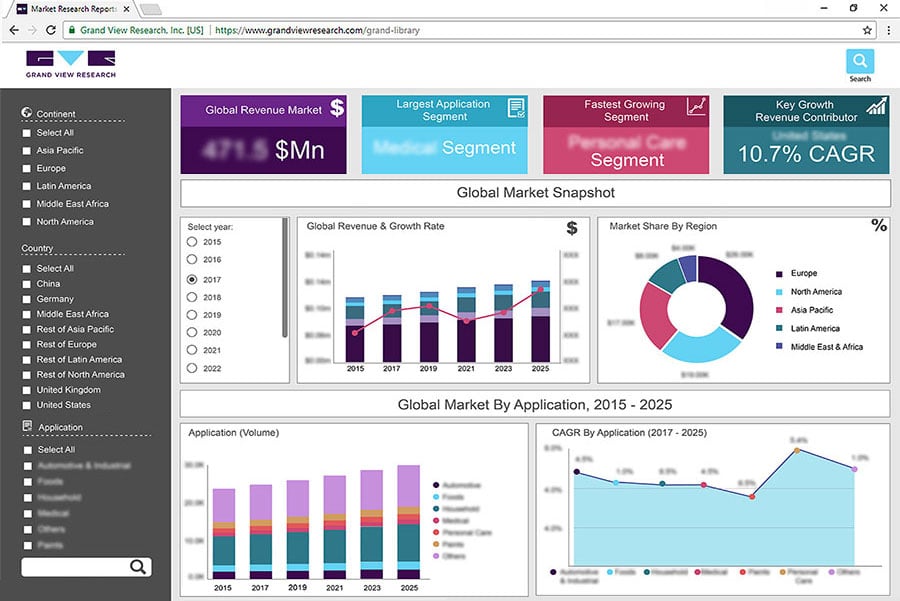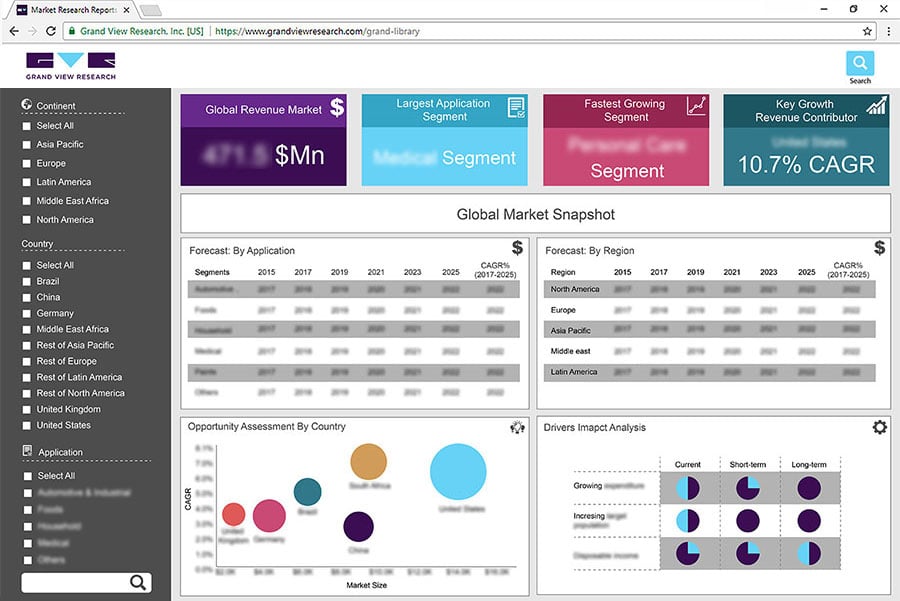
Commercial Refrigeration Equipment Market Size, Share & Trends Analysis Report By Product, By Application, By System Type (Self-contained, Remotely Operated), By Capacity, By Region, And Segment Forecasts, 2022 - 2030
- Report ID: 978-1-68038-531-1
- Number of Pages: 160
- Format: Electronic (PDF)
- Historical Range: 2018 - 2020
- Industry:Technology
Report Overview
The global commercial refrigeration equipment market size was valued at USD 37.25 billion in 2021. It is expected to expand at a compound annual growth rate (CAGR) of 5.1% from 2022 to 2030. The rapid expansion of the hospitality and tourism sector and the growing preference for end-consumers for takeaway meals are expected to drive the market growth over the forecast period. In addition, increasing regulatory pressures resulting in the adoption of lower Global Warming Potential (GWP) refrigerants coupled with the ongoing technological breakthroughs will also provide positive growth prospects for the market.

A considerable rise in the international food trade has also instigated the demand for the refrigeration of frozen foods, processed foods, and seafood. The continual innovations and rapid improvements in technologies, including liquid-vapor compression and ammonia absorption systems, are driving the product demand further. Various leading manufacturers are focusing on R&D activities to enhance the design and temperature control of their products to gain a competitive edge in the industry. The increasing need to control and monitor the environment of a commercial kitchen is expected to provide ample growth opportunities to the industry participants over the foreseeable future.
Products equipped with smart or automated refrigeration controls are gaining massive traction in the market. As per the Federal Energy Management Program, commercial refrigerators with ENERGY STAR certification consume 1.89 kWh energy per day on an average, while refrigerators with lesser efficiency consume the energy of around 4.44 kWh per day. The increasing demand for energy-efficient commercial refrigerators driven by the rising awareness about their environment-friendly and cost-effective nature is encouraging the market players to develop innovative designs.
The climate concerns related to high GWP refrigerants, such as global warming and ozone depletion, are urging the manufacturers to come up with alternatives. The rising demand for technologies that can address hazardous gas emissions has urged market participants to equip their products with advanced magnetic refrigeration systems. These systems also improve the energy efficiency of refrigeration equipment, thereby minimizing operational costs. As per the U.S. Department of Energy statistics, these systems are highly energy-efficient and can help in energy saving of up to 30%.
The worldwide outbreak of the COVID-19 crisis led to the establishment of stringent containment measures, resulting in a temporary halt in the manufacturing and shipment of commercial refrigeration equipment. However, the pandemic created a strong demand for vaccine production and storage, which triggered the demand for cold storage solutions to support the mass immunization program against the coronavirus. The accelerating usage of vaccine storage units is likely to propel the demand for transportation refrigeration equipment in the subsequent years.
Product Insights
The refrigerators and freezers segment accounted for a revenue share of more than 24.0% in 2021 across the commercial refrigeration equipment market. This can be attributed to the worldwide expansion of the travel and tourism industry, leading to the opening of various food joints and restaurants. The segment also covers blast chillers that are mainly used for prompt freezing or cooling of items at lower temperatures and stopping bacteria growth in the stored item. Besides, the wide adoption of chillers by healthcare professionals, to store tissue samples of vaccines, controlled tests, and critical medicines, is also contributing to the segment growth.
The beverage refrigeration segment is expected to record a CAGR of more than 5.0% over the forecast period owing to the increased deployment of medium-capacity beverage coolers for travelers and vacationers. Moreover, the emerging trend of ‘grab and go’ and ‘sip and shop’ across the retail chains to offer a better shopping experience to their consumers is expected to drive the demand for beverage refrigeration equipment in the forthcoming years.
System Type Insights
独立的部分持有超过85.0%的市场share in 2021 on account of the rising product demand owing to its advantages such as easy and cost-effective installation and low maintenance and relocation costs of the appliances. As per the Environmental Protection Agency (EPA) statistics, in 2020, the self-contained commercial refrigeration equipment produced around 26% of the overall HFC emissions globally. The stringent HFC emission norms are compelling the manufacturers to replace R-404A refrigerant with R-448A, minimizing the GWP of refrigeration equipment by around 70%.
Remotely operated refrigerators segment is expected to register a CAGR of close to 4% by 2030 with increasing adoption across the restaurants with limited kitchen space to reduce the heat produced by the refrigerators. These refrigerators offer less resonating noise than the self-contained refrigerator as the compressor unit is deployed outside the kitchen. However, they are less energy-efficient, and their installation requires professionals, which further increases the already high installation cost.
Capacity Insights
The 51 cu. Ft. to 100 cu. Ft. segment held a notable revenue share of around 48.0% in 2021, owing to the rising number of specialty food stores, hypermarkets, and supermarkets across the globe. The rapid adoption of reach-in refrigerators with a storage capacity of 50 cu. Ft to 75 cu. Ft in the commercial spaces is supporting the segment growth further. This has encouraged the manufacturers to deliver various turn-key products that can effectively serve the changing consumer demands.
The less than 50 cu. Ft. segment captured a revenue share of nearly 30.0% of the overall market in 2021. This can be majorly credited to the increasing need for various refrigeration equipment in this capacity range for highly concentrated application areas such as cold channel logistics and food service.
Application Insights
The food and beverage distribution segment is estimated to record a substantial CAGR of nearly 5.0% from 2022 to 2030. The ongoing developments in cold channel logistics for transporting temperature-sensitive items are positively impacting the segmental growth. Moreover, the demand for high-end temperature-controlled refrigerators for various transport vehicles for reliable distribution of beverages, liquor, fish, biopharmaceutical, and other perishable products is also favoring the business growth.
Besides, the growing proclivity of capital-intensive customers in the food & beverage distribution industry toward the sectional refrigerated trailers will drive the segment’s growth in the upcoming years.

The food service segment captured a revenue share of around 32.0% of the overall market in 2021. The sizable revenue share can be credited to the increasing trend of Quick-Service Restaurants (QSRs) and food trucks in the food service industry. According to the National Restaurant Association (NRA), there were more than 1 million restaurant locations in the U.S. in 2020, including QSRs, FSRs, bars, and taverns, which have a considerable demand for refrigeration equipment. Furthermore, the expansion of various prominent food and beverage chains, such as McDonald's, Subway IP LLC, and Starbucks Coffee Company is expected to impel the demand for commercial refrigeration equipment further.
Regional Insights
North America dominated the global commercial refrigeration equipment market in 2021 and is anticipated to account for over 32.0% of the revenue share by 2030. The significant growth can be largely attributed to the mature retail industry in the U.S. The region has a strong presence of numerous leading manufacturers of commercial refrigeration equipment. Moreover, the early adoption of smart equipment across commercial kitchens is also favoring the business expansion in the region.
The Asia Pacific is anticipated to observe a CAGR of over 6.0% by the end of 2030, owing to increasing product demand driven by the improving economic conditions, steady employment rates, growing gross disposable income, and rising expenditure on leisure activities, including traveling and dining out. Developing economies such as China and India offer lucrative opportunities for the market due to the high adoption rate of vaccine storage units across research institutions and biopharmaceutical companies. In addition, the flourishing travel and tourism industry in the countries such as Malaysia, Indonesia, and Singapore is expected to favor the regional market expansion.
Key Companies & Market Share Insights
The increased adoption of sustainable technology equipment has urged the major market players to launch new and enhanced product offerings to effectively cater to consumer demands. For instance, in January 2022, Carrier Commercial Refrigeration installed its PowerCO2OL refrigeration system at a COVID-19 vaccine storage warehouse in Spain. This system uses carbon dioxide, a natural refrigerant, and serves as a sustainable and low global warming potential refrigerant to help preserve critical vaccines in Spain.
Besides, the key players are also focusing on implementing various strategic initiatives such as capacity expansion, collaborations, mergers, and acquisitions to strengthen their foothold in the market. For instance, in November 2021, Whirlpool Corporation announced to invest over USD 65 million over the next few years into its factory based in Ottawa, Ohio to position the plant as the Premium Refrigeration Factory in North America. As a part of this strategic initiative, the company will expand the Ottawa plant to accommodate the manufacturing of premium refrigeration products, such as Built-In Refrigerator (BIR). Some of the prominent players operating in the global commercial refrigeration equipment market are:
AB Electrolux
Ali Group S.r.l. a Socio Unico
AHT Cooling Systems GmbH
Carrier
Daikin Industries, Ltd.
Dover Corporation
Hussmann Corporation
Excellence Industries
Hillphoenix, A Dover Company
Illinois Tool Works Inc.
Imbera
Lennox International Inc.
Metalfrio Solutions S.A.
Minus Forty Technologies Corp.
Ojeda Usa Inc.
Panasonic Corporation
Qingdao Hiron Commercial Cold Channel Co., Ltd.
True Manufacturing Co., Inc.
Victory Refrigeration
Whirlpool Corporation
Zero Zone, Inc.
Commercial Refrigeration Equipment MarketReport Scope
Report Attribute |
Details |
Market size value in 2022 |
USD 39.30 billion |
Revenue forecast in 2030 |
USD 58.31 billion |
Growth rate |
CAGR of 5.1% from 2022 to 2030 |
Base year for estimation |
2021 |
Historical data |
2018 - 2020 |
Forecast period |
2022 - 2030 |
Quantitative units |
Revenue in USD Billion and CAGR from 2022 to 2030 |
Report coverage |
Revenue forecast, company ranking, competitive landscape, growth factors, and trends |
Segments covered |
Product, system type, capacity, application, region |
Regional scope |
North America, Europe, Asia Pacific, Latin America, MEA |
Country scope |
U.S.; Canada; U.K.; Germany; China; India; Japan; Brazil; Mexico |
Key companies profiled |
Dover Corporation; DAIKIN Industries, Ltd.; Carrier; AB Electrolux; Ali S.p.A |
Customization scope |
Free report customization (equivalent to 8 analyst working days) with purchase. Addition or alteration to country, regional & segment scope. |
革命制度党cing and purchase options |
Avail customized purchase options to meet your exact research needs.Explore purchase options |
Segments Covered in the Report
This report forecasts revenue growth at global, regional, and country levels and provides an analysis of the latest industry trends in each of the sub-segments from 2018 to 2030. Grand View Research has segmented the global commercial refrigeration equipment market report based on product, application, system type, capacity, and region:
Product (Revenue, USD Billion, 2018 - 2030)
Transportation Refrigeration Equipment
Refrigerators & Freezers
Beverage Refrigeration
Display Showcases
Ice Merchandisers & Ice Vending Equipment
Other Equipment
Application (Revenue, USD Billion, 2018 - 2030)
Food Service
Food & Beverage Retail
Hypermarkets
Supermarkets
Convenience Store
Specialty Food Store
Others
Food & Beverage Distribution
Food & Beverage Production
Others
System Type (Revenue, USD Billion, 2018 - 2030)
Self-contained
Remotely Operated
Capacity (Revenue, USD Billion, 2018 - 2030)
Less than 50 cu. Ft
50 to 100 cu. Ft
More than 100 cu. Ft
Regional Scope (Revenue, USD Billion, 2018 - 2030)
North America
U.S.
Canada
Europe
Germany
U.K.
Asia Pacific
China
India
Japan
Latin America
Brazil
Mexico
Middle East & Africa
Frequently Asked Questions About This Report
b.The global commercial refrigeration equipment market size was estimated at USD 37.25 billion in 2021 and is expected to reach USD 39.30 billion in 2022.
b.The global commercial refrigeration equipment market is expected to grow at a compound annual growth rate of 5.1% from 2022 to 2030 to reach USD 58.31 billion by 2030.
b.North America dominated the commercial refrigeration equipment market with a share of 32.2% in 2021. This is attributable to the presence of well-established distribution channels for all categories of retail companies.
b.Some key players operating in the commercial refrigeration equipment market include Dover Corporation, DAIKIN Industries, Ltd., Carrier AB Electrolux, and Ali S.p.A.
b.Key factors that are driving the commercial refrigeration equipment market growth include rising demand for vaccine storage units during the cold supply chain activities to retain the immunization levels.
b.The refrigerators and freezers segment dominated the global commercial refrigeration equipment market and accounted for the highest revenue share of above 24.0% in 2021.
b.The self-contained segment accounted for over 85.0% of the global commercial refrigeration equipment market in 2021.
b.The 51 cu. Ft. to 100 cu. Ft. segment dominated the global commercial refrigeration equipment market and accounted for a revenue share of close to 48.0% in 2021.
b.The foodservice segment dominated the global commercial refrigeration equipment market in 2021, accounting for a revenue share of over 31.0%.




